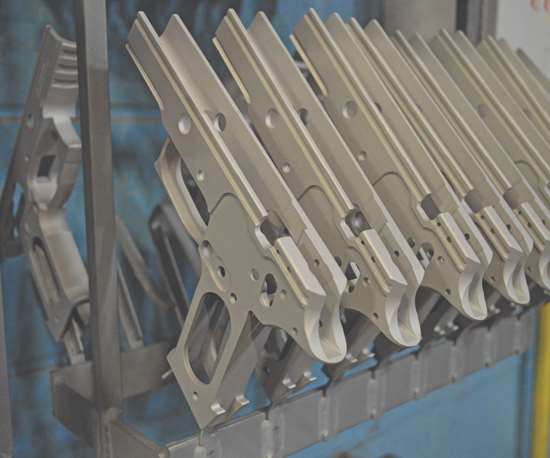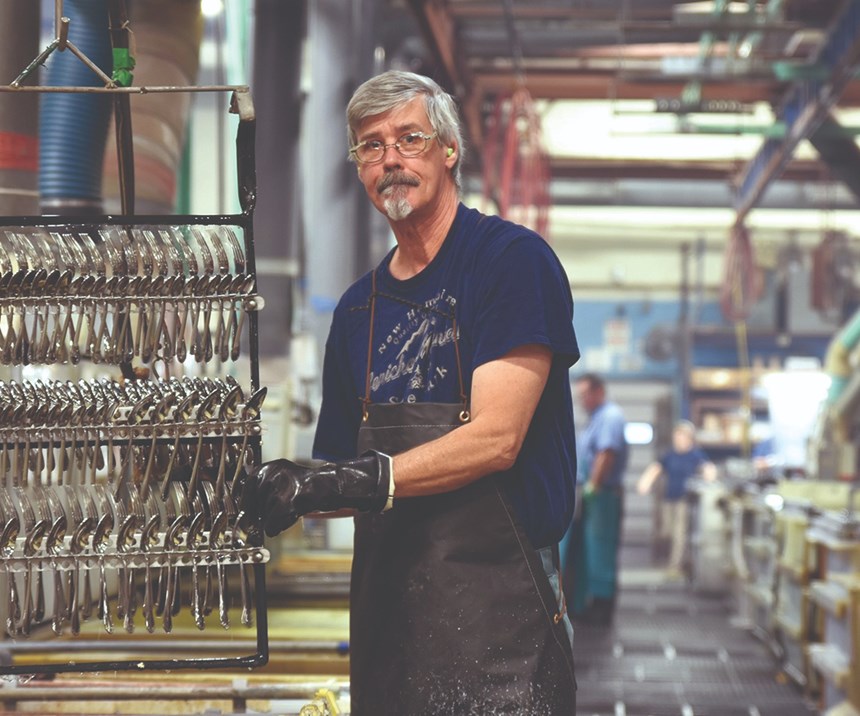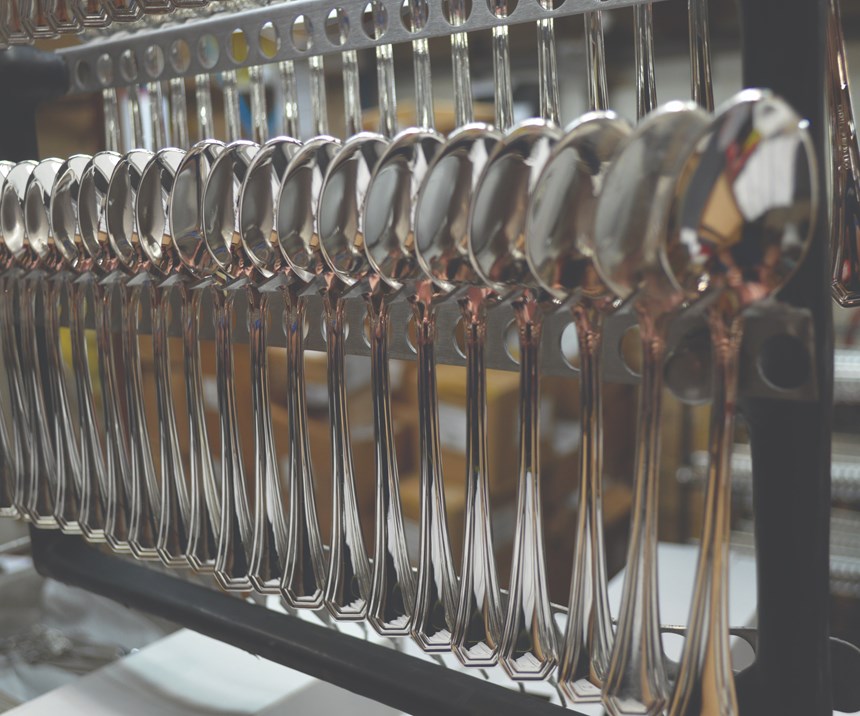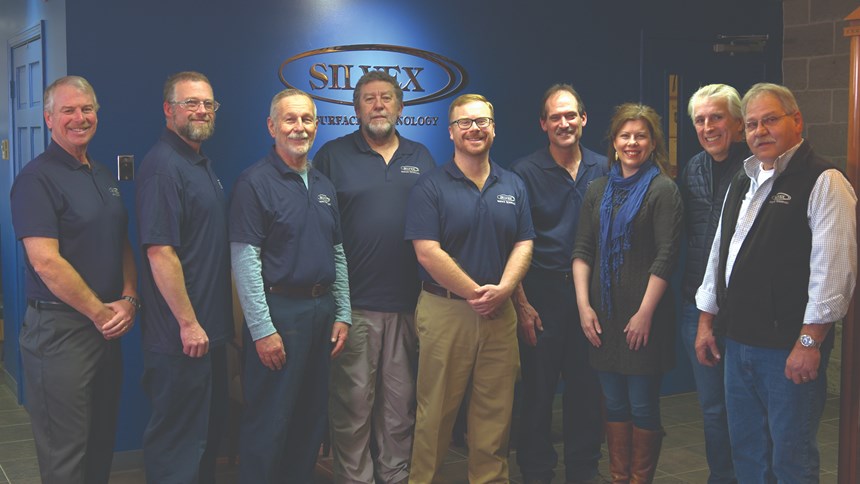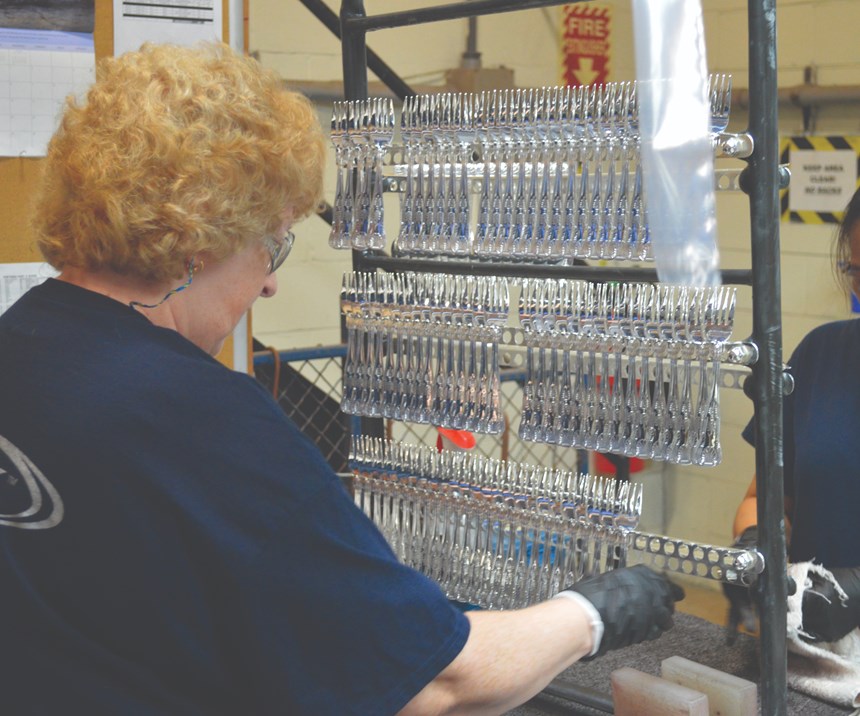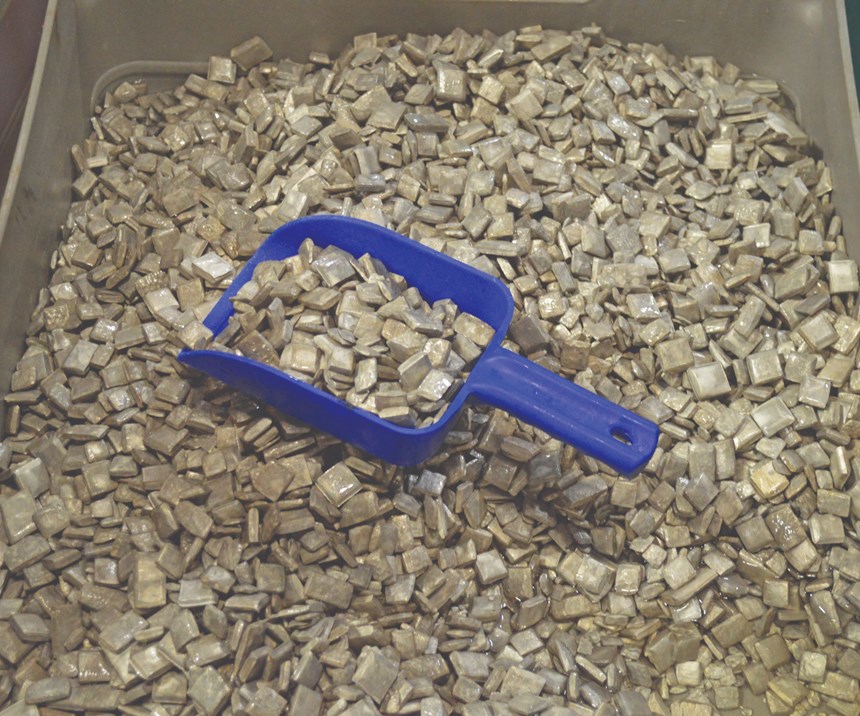Diversity is the name of the game at Silvex, a second-generation family plating facility located in Westbrook, Maine.
On one side of their expansive 40,000-square-foot facility are products from nearly every major gun manufacturer in the U.S. Handguns, military firearms and other parts line one wall of the operation, giving it that distinct ‘man-cave’ flavor.
The other side of the facility is a completely separate operation, both in style and substance. Silvex is one of the largest finishers of tableware and flatware in the U.S., capable of plating more than 20,000 items each shift, including forks, knives, spoons and just about anything else you might find in a suburban home or upscale hotel.
In the variation of the phrase, Silvex is an absolute ‘mom and pop’ operation, that is if your father loves his guns and your mother treasures her eating utensils.
“We do have variety in what we produce,” says Phil Ridley, president of the company that his father-in-law, Richard Atkinson, acquired in 1968. “It’s very different.”
By its name alone, it is obvious that Silvex specializes in silver plating, but its processes are more far-reaching. It also has a significant specialty in advanced platinum plating processes, and has ISO 9001:2015, Nadcap, AS91000 and several other certifications for
the defense, aerospace, power generation and medical industries.
Besides silver and platinum, the shop offers gold, nickel, copper, tin and sulfuric, and hardcoat anodize, chemical film, cyanide copper, acid copper, electroless nickel, manganese phosphate, passivate, Teflon PTFE, zinc and manganese phosphate, black oxide and black passivate. They recently added a nickel molybdenum plating line.
Silvex meets numerous ASTM, ANS and military specifications and, in 2016, increased its capacity and invested in automatic blasting machinery, parts washers and new rectifiers to finish thousands of firearm parts daily, all while continuing to meet very stringent manufacturer requirements by some of the top companies in the world.
Rise in Gun Sales Spurs Growth
The shop got its start in the firearms industry with Bushmaster Firearms, when the gun manufacturer was just a small startup in Maine in the early 1970s.
“Bushmaster was still working out of their garage when we first met them,” says Dan Atkinson, son of the founder and the vice president of sales. “They had about four employees, and we grew in firearms as they did. It’s been a great relationship for us both.”
Silvex did work for a few other smaller gun manufacturers in the 1990s and 2000s before the big boom in gun sales hit when the fear of gun owners' second amendment rights could be infringed upon. The National Shooting Sports Foundation (NSSF), a trade association for firearms industry, says that the economic impact of the firearms and ammunition industry in the U.S. increased from $19 billion in 2008 to over $49 billion in 2015, or about a 158 percent increase in seven years.
When Sig Arms opened in Exeter, New Hampshire, to assemble its P225, P226 and P228 9mm firearms, they began a relationship with Silvex, which now counts Sig Sauer as one of its largest customers.
“A former customer of ours began working there in purchasing and contacted us to assist them with some finishing issues,” Atkinson says. “We were in the right place at the right time to take advantage of that industry. Everything has just continued to grow from then.”
The NSSF says that in the same time period from 2008 to 2015, the number of full-time employment related to gun manufacturing in the U.S. increased from about 166,000 to almost 288,000. Maine also happened to be the state that saw the third most job growth in gun-related employment from 2008 to 2015, the NSSF says, behind Wyoming and Alaska.
Firearms sales were stagnant the last two years, as the U.S. government reported a lower number of federal background checks that were precursors to buying a gun. But late in 2018, the numbers began picking up again, with Smith and Wesson showing stronger earnings (up almost 8 percent), and Sturm, Ruger and Co. also reporting a higher number of sales.
“We have been very much like chameleons over the past several decades as far as the business cycles have gone,” Ridley says. “At one time, plumbing and computers were our primary customer base and then aerospace and silverware. But firearms has been a mainstay for the past decade or so, and the business has been very good for us.”
With a customer base consisting of Sig Sauer, Ruger, Windham Weaponry, Remington and more, Silvex has become one of the industry experts in firearms finishing. They have invested in three automatic rotary blast machines, a parts washer, stress tester, and expanded capacity in hard anodize—with another expansion slated for 2019—as well as having added Class 4 black oxide for molded-injection metal products.
Featured Content
Hard Anodizing Firearms
For many of the gun manufacturers, Silvex provides a matte hard black anodize on upper and lower receivers, pistol frames, handles, rail adapters and numerous other components made of 6000 and 7000 series aluminum.
Atkinson says their process complies with MIL-A-8625 Type III Class 2, where coating thickness ranges from .001 to .002 with tolerances controlled to +/- .0002, and a 50 percent overall thickness penetration with a hardness of 350 vickers.
Upon arrival to the Silvex plant, the parts are cleaned, then grit blasted with a blasting media that mattes the aluminum prior to finishing to ensure consistency and reduce reflectivity. The parts are racked on numerous part-specific designed rack fixtures that Atkinson says minimizes thickness variations, reduces rack marks and prevents loss.
The current is controlled in the sulfuric acid anodize solution with energy-efficient, part-programmable rectifiers that reduce the potential for human error. Most of the firearm parts are dyed black and sealed in nickel acetate or Teflon PTFE. Thicknesses are then verified utilizing a Fischer scope.
Ridley says that Silvex offers both manganese and zinc phosphate that meet Mil-STD-171, Mil DTL and DOD-16232 Type M or Z specifications in Class I, II and III. The parts are first cleaned to remove oil and grease and then prepared with an abrasive blast to remove scale and rust, promote good adhesion and provide a matte uniform finish. Ridley says that the weight coating of the finishes are typically a minimum of 16 grams per square meter for manganese and 11 grams per square meter for zinc.
The Class II coatings are impregnated with oil that meets the MIL-PRF-3150 specification and are generally for chrome-lined and nonchrome-lined gun barrels, barrel extensions, flash suppressors, barrel nuts, extractors and bolt carriers. Ridley says that Silvex also designed a proprietary masking procedure for nonchrome-lined gun barrels that enables them to process thousands of barrels successfully with no leakage.
New Facility for Flatware
In 1984, Ridley designed the new headquarters in Westbrook, Maine, specifically to serve the silverware industry. At the time, International Silver (Meriden, Connecticut), was one of the oldest and largest silverware manufacturers in the world, but was closing their factory. They contacted Silvex about doing all their silver plating, and the shop was determined to take advantage of the opportunity.
The new facility received accolades for its totally enclosed design and efficient layout, including a sophisticated waste water treatment system. Silvex also changed its name from Maine Metal Finishing to reflect their silver plating specialty and added an “ex” on the end of the name to give it a bit of a high-tech sound to coincide with the electronic industry growth in New England, says Ridley.
It wasn’t long before Silvex was finishing over 10 million parts per year for companies such as World Tableware, Table DeFrance, Towle Silver and Reed and Barton.
The work is performed on an ISO9001:2008 and AS9100D certified production line designed specifically for plating knives, forks and spoons. Silvex uses a hoist-operated production line utilizing specially designed rack fixtures for good adhesion and consistent thicknesses. The process also allows some flexibility in the operation to vary for specific customer requirements. The three-stage cleaning includes an ultrasonic machine to remove grease, oils and buffing compounds before the application of a 3-micron layer of nickel plate under the silver that helps promote corrosion resistance, increase the hardness and brighten the finish.
Atkinson says the 99 percent pure silver layer is done in thicknesses of 6, 7, 10, 20 and 33 microns, which are verified with an X-ray fluorescent machine. Proper adhesion is confirmed with a prolonged burnish in a machine with an aggressive media. Atkinson says that if there is any evidence of poor adhesion, the lot is rejected and reprocessed.
In 1979, Pratt & Whitney opened a new manufacturing facility in North Berwick, Maine, and Silvex soon became their primary finishing supplier for anodizing engine shrouds, electroless nickel on titanium, stripping ceramic off nickel-based super alloys such as Hastelloy, and platinum plating. This also enabled Silvex to diversify into the aerospace industry, which has since grown into a niche sector of their business and lead Silvex into obtaining the AS 9100D and Nadcap certifications. Furthermore, it allowed Silvex to enter into the platinum plating market, which has grown into another niche sector for the company.
Learning from the Superconducting Super Collider
Not everything works out as planned, though. Silvex put a lot of resources into the superconducting super collider that was planned to be built in Texas in the 1990s by Brookhaven National Laboratories. It was a $2 billion dollar project that required Silvex to copper plate the internal diameter of a 60-foot stainless steel tube that was an inch in diameter to a specification of .003 +/- .0003.
The award of the contract came down to Silvex and a firm from Switzerland, and the Maine company won the contract.
“We did about 100 tubes for them successfully, and it was going to be a considerable part of our future,” Ridley says. “We had plans to expand our facility, almost double in size. It would have been huge for us.”
But the administration and Congress canceled the project in 1993, which forced Silvex to focus on developing other types of work.
“We did get a lot of experience out of it,” Ridley says with a hint of disappointment. ”We could have pulled it off, and it was very exciting to work with those companies.”
Today, about 65 percent of the work Silvex does is firearms, 10 percent is flatware, 8 percent is telecom and electronics, and 5 percent is aerospace. The rest is from various other industries.
“The firearms industry, obviously, is quite volatile and can be cyclical,” Atkinson says. “Generally, there is an increase in demand during election years as gun control issues come to the forefront and second amendment discussions heat up.”
He says other factors that can affect demand are new products, a crisis or event and foreign sales.
“After the presidential election, business actually slowed down for a while,” he says. “However, lately, we are starting to see things get busier again. I expect our presence in the firearms industry will only continue to grow as we promote ourselves more nationally. Word of mouth goes a long way in this industry too.”
For information on Silvex, visit silvexinc.com.
RELATED CONTENT
-
Reducing Hexavalent Chromium in Military Anodizing Operations
How U.S. Air Force facilities transitioned a dichromate sealer replacement.
-
Protecting the Troops—and Their Equipment
CARCs advance with U.S. military
-
Development of Life Prediction Models for High Strength Steel in a Hydrogen Emitting Environment
Solvent substitution for maintenance and overhaul operations of military systems has been a primary environmental concern for many years. Cadmium replacement in these systems has been targeted for decades. Both of these areas have a common obstacle for implementation of any potential alternate. Hydrogen embrittlement of high strength steel is the most predominant unforeseen hurdle since high strength materials show sensitivity to the phenomena and the source of the hydrogen can be anything within the fabrication process, maintenance practice or the natural corrosion cycle. Standardized testing on this issue has traditionally stemmed from the aerospace industry where it is a principal focus.



